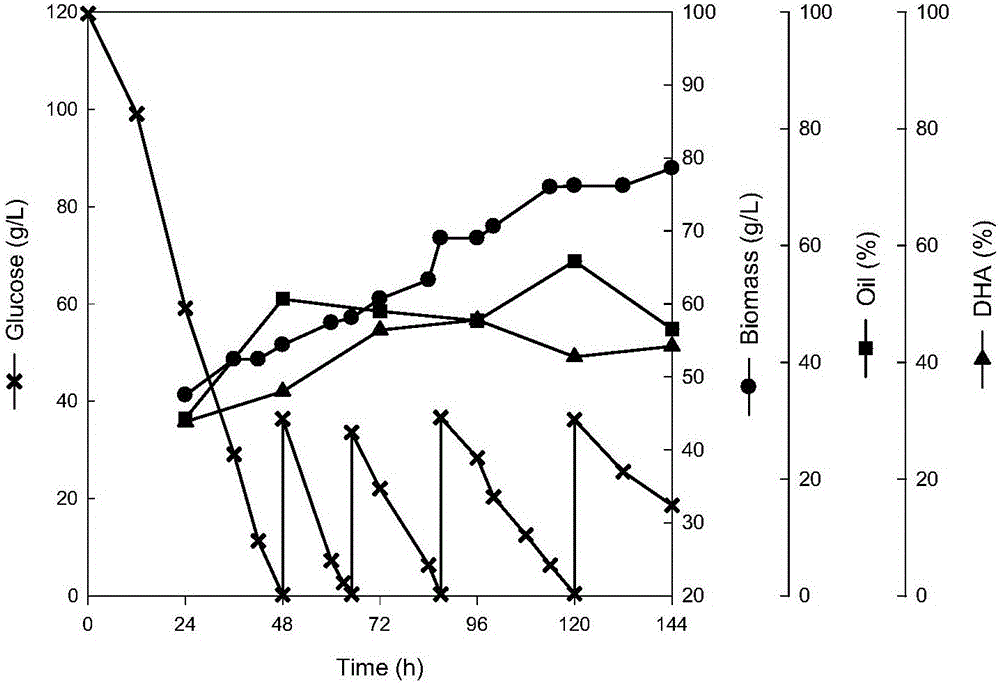Method for producing docosahexaenoic acid by fermentation tank substrate feeding
A docosahexaenoic acid and fermenter technology, applied in the direction of microorganism-based methods, biochemical equipment and methods, fermentation, etc., can solve problems such as unfavorable synthesis
- Summary
- Abstract
- Description
- Claims
- Application Information
AI Technical Summary
Problems solved by technology
Method used
Image
Examples
Embodiment 1
[0029] 1) Activation of strains: The strain Schizochytrium sp. LU310 preserved at -70°C was transferred to the plate medium, and cultured at 28°C for 24-48 hours to obtain activated strains and observe the colony morphology. The composition of the plate medium is (g / L): glucose 30, yeast powder 10, Na 2 SO 4 12. MgSO 4 2. KH 2 PO 4 1, (NH 4 ) 2 SO 4 1, K 2 SO 4 0.65, KCl 0.5, CaCl 2 .2H 2 O0.17, agar 15, pH adjusted to 6.5.
[0030] 2) Primary seed culture: select the plate colonies in step 1) with good morphology, pick them with an inoculating loop and insert them into a 250 mL flat-bottomed conical flask containing 50 mL of seed medium, and cultivate at 28° C. and 200 rpm for 24- 48h; the composition of seed medium is (g / L): glucose 30, yeast powder 10, Na 2 SO 4 12. MgSO 4 2. KH 2 PO 4 1, (NH 4 ) 2 SO 4 1, K 2 SO 4 0.65, KCl0.5, CaCl 2 .2H 2 O 0.17, the pH was adjusted to 6.5, and the first-class seed culture solution was obtained.
[0031]...
Embodiment 2
[0037]1) Activation of strains: The strain Schizochytrium sp. LU310 preserved at -70°C was transferred to the plate medium, and cultured at 28°C for 24-48 hours to obtain activated strains and observe the colony morphology. The composition of the plate medium is (g / L): glucose 30, yeast powder 10, Na 2 SO 4 12. MgSO 4 2. KH 2 PO 4 1, (NH 4 ) 2 SO 4 1, K 2 SO 4 0.65, KCl 0.5, CaCl 2 .2H 2 O0.17, agar 15, pH adjusted to 6.5.
[0038] 2) Primary seed culture: select the plate colonies in step 1) with good morphology, pick them with an inoculating loop and insert them into a 250 mL flat-bottomed conical flask containing 50 mL of seed medium, and cultivate at 28° C. and 200 rpm for 24- 48h; the composition of seed medium is (g / L): glucose 30, yeast powder 10, Na 2 SO 4 12. MgSO 4 2. KH 2 PO 4 1, (NH 4 ) 2 SO 4 1, K 2 SO 4 0.65, KCl0.5, CaCl 2 .2H 2 O 0.17, the pH was adjusted to 6.5, and the first-class seed culture solution was obtained.
[0039] ...
Embodiment 3
[0045] 1) Activation of strains: The strain Schizochytrium sp. LU310 preserved at -70°C was transferred to the plate medium, and cultured at 28°C for 24-48 hours to obtain activated strains and observe the colony morphology. The composition of the plate medium is (g / L): glucose 30, yeast powder 10, Na 2 SO 4 12. MgSO 4 2. KH 2 PO 4 1, (NH 4 ) 2 SO 4 1, K 2 SO 4 0.65, KCl 0.5, CaCl 2 .2H 2 O0.17, agar 15, pH adjusted to 6.5.
[0046] 2) Primary seed culture: select the plate colonies in step 1) with good morphology, pick them with an inoculating loop and insert them into a 250 mL flat-bottomed conical flask containing 50 mL of seed medium, and cultivate at 28° C. and 200 rpm for 24- 48h; the composition of seed medium is (g / L): glucose 30, yeast powder 10, Na 2 SO 4 12. MgSO 4 2. KH 2 PO 4 1, (NH 4 ) 2 SO 4 1, K 2 SO 4 0.65, KCl0.5, CaCl 2 .2H 2 O 0.17, the pH was adjusted to 6.5, and the first-class seed culture solution was obtained.
[0047]...
PUM
 Login to View More
Login to View More Abstract
Description
Claims
Application Information
 Login to View More
Login to View More - R&D
- Intellectual Property
- Life Sciences
- Materials
- Tech Scout
- Unparalleled Data Quality
- Higher Quality Content
- 60% Fewer Hallucinations
Browse by: Latest US Patents, China's latest patents, Technical Efficacy Thesaurus, Application Domain, Technology Topic, Popular Technical Reports.
© 2025 PatSnap. All rights reserved.Legal|Privacy policy|Modern Slavery Act Transparency Statement|Sitemap|About US| Contact US: help@patsnap.com



